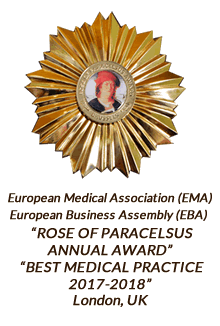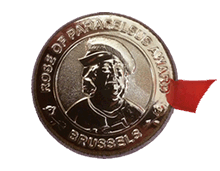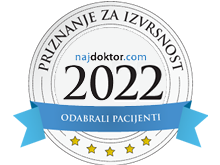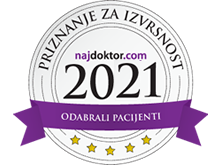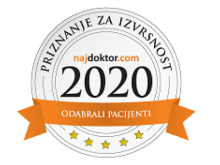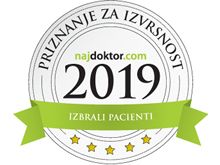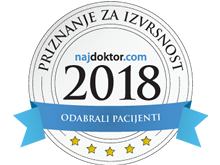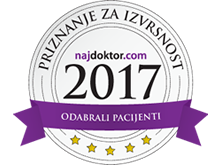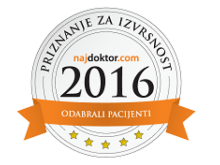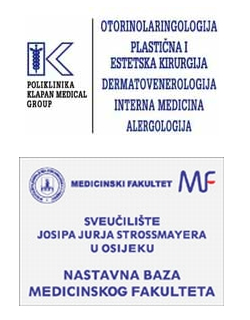Published as: Klapan Ivica et all., Am J Otolaryngol, 1995, 16(6):396-402.
Institutions:
- University Polyclinic Klapan Medical Group, Zagreb, Croatia and Department of Otorhinolaryngology, Head&Neck Surgery, Division of Plastic andReconstructive Head & Neck Surgery and Rhinosinusology, Zagreb University School of Medicine, Zagreb, Croatia
- Department of Physiology, Zagreb University School of Medicine,
- Division of Biochemistry, Clinical Hospital “Sestre Milosrdnice”, Zagreb
Address for correspondence:
Address for correspondence: Professor Ivica Klapan, MD, PhD, University Polyclinic Klapan Medical Group, Ilica 191A, HR-10000 Zagreb, Croatia
Keywords: Sinonasal polyposis, Arachidonic acid, Leukotrienes
ABSTRACT
Purpose: The etiology of sinonasal polyps is sometimes obscure. This study was undertaken to evaluate the potential role of arachidonic acid metabolites (AAm) on recurrent polyposis.
Purpose: The etiology of sinonasal polyps is sometimes obscure. This study was undertaken to evaluate the potential role of arachidonic acid metabolites (AAm) on recurrent polyposis.
Materials and Methods: Tissue production of prostaglandin E2 (PGE2), 6-keto-prostaglandin F1-alpha (PGI2), thromboxane A2 (TxA2), and leukotriene C4 (LTC4) by nasal mucosa was determined by radioimmunoassay in 27 patients with sinonasal polyposis (SNp) and in 10 volunteers.
Results: The group of patients with SNp with the evidence of recurrences in postoperative period (Group 1) showed significantly lower PGE2 concentrations than group of patients with SNp recurrences (Group 2). The differences in concentrations of PGI2 in mentioned groups were insignificant. In comparison with other groups, a group of patients whounderwent surgery several times for SNp (Group 4) had a higher mean TxA2 concentration. The LTC4 concentrations were the highest in groups of patients where SNp recurrences were observed. When the incidence of polyposis recurrences (within 18 months after surgery) was correlated with the level of LTC4 production at the time of surgery, the rate of recurrence was significantly higher in patients with increased LTC4 level than in those with normal LTC4 levels.
Conclusions: LTC4 might have a prognostic value. The possible role of Aam in occurrence of SNp is apparent and suggests possible role for medical intervention.
INTRODUCTION
Arachidonic acid metabolites (AAm) have an important regulatory function within several areas of otolaryngology, such as modulation of immune1 and allergic response,2 inflammation,3 and cancer.4-7 Cyclooxygenase converts AA into prostaglandins (PGs) and thromboxanes (Txs), whereas lypooxigenase converts it to hydroxyeicosatetraenoic acids (HETEs) and leukotrienes (LTs).8 Nonsteriodal anti-inflammatory drugs, like aspirin, inhibit the cyclooxygenase and stimulate the lipooxigenase pathway, resulting in increased production of HETEs and LTs, whereas corticosteroids inhibit the release of AA from membrane phospholipids, causing a decrease of both lipooxygenase and cyclooxygenase products.8
The etiology of sinonasal polyposis (SNp) is still obscure, and so are the possible mechanisms responsible for its formation and development. It has been shown that cell- mediated immune reactions9 or their disturbances,10 as well as basophils,11 might play an important role in the pathogenesis of SNp. In the epithelium of nasal polyps, suppressor-cytotoxic T cells (CD8+) were more frequently observed than helper-inducer T cells (CD4+) and were not located close to mast cells9. On the other hand, CD4+ cells were commonly observed in the submucosal layer and in the connective axis.12 Also, evidence has been given that mast cells, displaying interleukin-2 (IL-2)-receptor, are very often related to CD4+ and major histocompatibility complex (MHC) class II-positive T lymphocytes.9 Furthermore, the increased number of mast cells and their degranulation, 12 caused by activated T-cell cytokines, play an important role in the development of edematous changes in Snpformation.13 The capillaries in SNp appear small in number but have very high permeability.14 Recent data suggest that transforming growth factor b 1 (TGF-b-1), synthesized by most prevalent inflammatory cells in SNp-eosinophils,15 contributes to the structural abnormalities (eg. Stromal fibrosis and basement membrane thickening), characteristic of SNp.16 Also, urokinase-type plasminogen activator (u-PA) in inflammatory tissue has been shown to be related to proliferative changes of the mucous membrane.17 A significant decrease in nasal mucociliary clearance was also observed in patients with SNp.18
SNp was considered a manifestation of allergy in at least a part of patients. Recently, many investigators have shown that a number of patients with SNp have no obvious evidence of allergic disease per se 19,20 and that non-immunoglobulin E-mediated mechanism are responsible for triggering the release of histamine from nasal polyp mast cells.21 Also, it has been shown that the increased number ofmetachromatic cells in the epithelium of SNp and adjacent nasal mucosa is not allergy-dependent.22 On the other hand, allergic rhinitis, asthma, chronic sinusitis, and aspirin sensitivity are frequently associated with SNp.23 However, it has been shown that they are not under the allergic influence and the both prostaglandins and leukotriens contribute to the formation of edema.24
Although AAm have been described as products synthesized by human SNp tissue,8 no prospective study on AAm metabolism in either SNp or adjacent SN "polypoid" mucosa, or in normal mucosa, has been performed so far. Thus, the aim of this study was to highlight this problem. The AAm used for this analysis were chosen because: A) leukotriene (LTC4) was reported to has important role in the pathogenesis of nasal polyps8; B) using PGE2 and PGI2 as potent vasodilatators; PGI2 could block formation of LTs over AAm system; and C) TxA2 could be used as vasoconstrictive AAm.
MATERIALS AND METHODS
Production of Eicosanoids
Samples of SNp (adjacent sinus or nasal polypoid) and normal mucosa were obtained at the time of surgery and processed essentially as described before.25 Briefly, the samples were kept on ice in phospate-buffered saline (PBS) and within 30 minutes minced and processed for measuring the AAm production. Tissue was minced into small fragments (1 to 3 mm3) in cold PBS and washed 3 times more in fresh PBS by sedimentation at unitgravity for 2 to 3 minutes. The fragments weretransferred in preweighed tubes, sedimented, and resuspended in Minimum Essential Medium (1 mg tissue/5-10 mL MEM) and incubated for 1 hour in waterbath at 37oC. Following centrifugation at 300g for 2 minutes, supernatants were pipetted and stored at –70oC until determination of eicosanoid concentrations.
Radioimmunoassays for Eicosanoids
The level of PGE2, PGI2, TxA2, and LTC4 were determined by radioimunoassay (RIA) procedure, using appropriate kits (Amersham, UK). The procedure of manufacturer was followed strictly. The following kits were used: RIA PGE2, PGI2, TxA2, and LTC4. The determination of PGE2 is based on the conversion of the major PGE2 metabolite (13,14-dehydro-15-keto-PGE2) to a stabile bicyclic compound (11-deoxy 13,14-dehydro-15-keto-11 b, 16E-cyclo PGE2) using sodium carbonate. The amount of free tracer in the supernatant was determined by counting in a beta scintillation counter. The level of unlabeled bicyclic PGE2 was determined from a linear standard curveusing log-logit graph paper. All assays were performed in triplicate, and each sample was tested twice.
The assays for the detection of 6-keto-prostaglandin F1-alpha (a stabile metabolite of PGI2) and TxB2 (a stabile metabolite of TxA2) or LTC4are based on the competition between unlabeled eicosanoide and a fixed amount of the (3H) labeled compound for specific antibody. Separation of the protein-bound 6-keto-PGF1-alpha, TxB2, or LTC4 from the unbound ligand is achieved by adsorptionof the free component onto dextran-coated charcoal, followed by centrifugation. Measurement of the radioactivity in tzhe supernatant and determination of the concentration of unlabeled 6-keto-prostaglandin F1-a were performed as for PGE2.
Patients
AAm production was analyzed in SNp and in control tissue samples of 37 patients undergoing functional endoscopic sinus srgery at the ENT Department, School of Medicine, University of Zagreb, Croatia. Initialy, 63 patients surgically treated for SNp were included in the study. Twenty-six of them were excluded for various reasons: 4 patients have no follow-up data, 8 patients had been treated with corticosteroids and 6 with antiallergic medication before the operation, and 8 had sniffered an upper-respiratory illness 2 weeks before the surgery. All patients underwent a complete otolaryngologic examination. Computerated tomography (CT) echocardiograms , diagrams, and pathologyreports there done routinely in each case. There were 22 man and 15 women, aged 37 to 66 years (mean age 58). CT-diagrams showed almost all sinuses and noses tunnels completely occupied with no evidence of the main landmarks of the lateral wall in almost all patients who underwent classical technique surgery more than one (Group 4). On the contrary, Groups 1 and 2 showed relatively clear anatomic landmarks in sinuses and nose and polyp tissue, which were relatively isolated in the above mentioned areas.
All patients were followed-up for 18 months and periodically examined (at least twice a year) for recurrence of the main disease. One control group included 10 patients treated at the ENT Department for various non-SNp-related diseases. They were treated for otitis media (n=3), nodulus plicae vocalis (n=3), and septal deformities (n=4). There were 7 man and 3 woman age 20 to 61 years (mean age 41,7 years). Control mucosa tissue was taken from their noses in the superior part of middle turbinates. This maneuver was performed with patient's consent. Another control group consisted of 5 patients previously threated for SNp pathology who still suffered from the mentioned disease. These patients were age 31 to 53 years (mean age, 39,1 years). This group was chosen to be a second control group, because in the hypothesis was made before the study that polyposis recurrences in this patients could be different from "normal" SNp in untreated patients. The differences in CT diagrams between the groups were the another reason for such creation of the study. We expected to find the difference in AAm production between previously untreated patients (Group 1/Group 2) and patients who had had no response of both maximal medical and surgical therapy.
Statistics
The tissue AAm production was presented as mean ±SD, and statistical comparisons were done by Mann-Whitney-U test and Kruskal-Wallis oneway Anova test. The normality of data distribution was estimated by Kolmogorov-Smirnov Goodness of fit test. Post hoc miltiple comparisons were done with Tukey-HSD for unequal sample sizes test modified according to Spjotvoll and Stoline.
RESULTS
Since the production of eicosanoids differed greatly between the patients who had undergone surgery for SNp and have no disease recurrence within 18 months, and those who had disease recurrence during the same period, data for this two groups of patients are shown separately.
As shown in Table 1, the mucosa of the surgically treated patients with no recurrence produced less PGE2 (Group 1; 0.52 ± 0.27 pg/mL) then the mucosa of the patients with disease recurrence (Group 2; 1.24 ± 0.72 pg/mL). It was also lower then the PGE2 production af healthy mucosa (Group 3; 0.79 ± 0.72 pg/mL) or of mucosa of the patients who previously underwent surgery for SNp on several occasions (Group 4; 0.93 ± 0.77 pg/mL). Mann-Whitney-U test showed significant difference in PGE2 levels between the Groups 1 and 2 (P= .002; see Table 2), as well as between the Groups 2 and 3 (P= .048), but there was no significant diference between the groups with SNp (Group 1, Group 2, Group 4) and normal mucosa (Group 3).
Table 1 also shows that the concentration of PGI2 in Group 1 (2.06±2.46 pg/mL) was lower then in Group 2 (2.51±1.76 pg/mL), but higher then in Group 3 (1.46±1.035 pg/mL) or in Group 4 (1.63±1.29 pg/mL). No significant difference was observed in synthesis in PGI2 in investigated groups.
The mean TxA2 concentration in Group 2 (2.03±0.95 pg/mL) was higher than in Group 2 (2.02±0.81 pg/mL) or in Group 3 (1.54±0.42 pg/mL), and lower than in Group 4(2.42±0.29 pg/mL) (Table1). Significant difference was found between Group 1 and Group 3 (P= .046) as well as between GR3 and GR4 (P= .002) (Table 2).
The concentration of LTC4 was the lowest in Group 1 (8.99±4.04 pg/mL), followed by Group 3 (12.30±6.10 pg/mL), Group 2 (21.44±12.42 pg/mL) and Group 4 (21.01±9.99 pg/mL) (Table 1). Significant difference was found between Groups 1 and 2 (P= .001), Groups 1 and 4 (P= .004), Groups 2 and 3 (P= .041), and Groups 3 and 4 (P= .050)thus highest LTC4 concentrations were observed in the patients who were not free of the disease, ie in the patients with SNp recurrences during the postoperative period or in the patients who suffered from SNp and previously underwent surgery for the mentioned pathology on several occasions.
Table 3 shows the incidence of SNp recurrences in surgically treated patients according the level of LTC4 production at the time of surgery. The patients were divided into 2 groups; those who had an increased LTC4 production, ie value which was 2 SD higher themn the mean value in healthy mucosa (Group 3) (³24.51 pg/mL) and those with the production of LTC4 within the normal range (£24.51 pg/mL). Recurrences were recorded in 4 out of 4 patients (100%) with increased LTC4 concentration, and in only 6 of 18 patients (33.3%) with decreased LTC4 concentration. The difference was significant (Fisher exact test; P= .28). Concentration of other metabolites did not show any similar correlation.
Using Kruskal- Wallis one-way Anova analysis of variance for LTC4, we observed significant differences (P= .0019) with 3 degrees of freedom (chi-square = 14.9). The highest Mean Rank is in the Group 4 (30.0), then in Group 2, Group 3, and Group 1. PGE2 data tests also had significant differences (P= .03) with 3 degrees of freedom (chi-square = 8.46). The highest Mean rank is in the Group 2 (28.65), then in Group 4, Group 3, and Group 1. While testing PGI2, we observed no significant differences (P= .39). TxA2 data tested with this test showed significant differences (P= .04), chi-square 0 8.0 with highest Mean Rank in Group 4 (27.1) (Table 4).
Post hoc multiple comparisons were done with Tukey-HSD for unequal sample sizes (Test modified according to Spjotvoll and Stoline). This test showed significant differences between Groups 1 and 2 (P£ .05) and groups 1 and 4 (P£ .05) for LTC4. Significant difference was observed only between Groups 1 and 2 (P£ .05) for PGE2. No two groups are significantly different at the 0.05 level for PGI2 and TxA2.
DISCISSION
Several recent investigations have shown AAm characteristics have change, ie it's more active in SNp allergic patients then in nonallergic patients.26 In our study, we also found a higher mean AAm concentration in allergic patients than in nonallergic patients (59.1% and 40.9% of all patients, respectively), but the difference was not significant (data not shown). This may be caused by the small number of patients included in study.
Furthermore, an increased synthesis of lipoxygenase products of AA, predominantly LTs, has been reported, which may account for the increased glandular secretion in the upper airways.27 In addition, conversion of LTA4 to lipoxins and 15-HETE acid has been reported to be 3 to 5 times higher in SNp,28,29 suggesting the possible pathogenetic role of this products. Finally, high level of LTs and low level of PGs in SNp were found to be associated with aspirin-sensitive asthma (ASA).30 Although we found a somewhat higher LTC4 level and lower levels of PGE2, PGI2 and TxA2 in our ASA patients, these differences were not significant, probably because of the small number of patients inclouded in study (data not shown). However our results appeared to indicate that LTC4 production is higher in patients in whom SNp recurred after surgery (Group 2) or in those who had had several surgeries and recurrences (Group 4), then in patients free of disease recurrence after the surgery (Group1). The level of LTC4 production appeared to have a predictive value, ie the higher the production, the more frequent the disease recurrence after the surgery. The possible pathogenic role of LTC4 might be the induction of vascular dilatations and mucous secretion, or formation of stromal edema, or cellular infiltration, and so on.8 LTC4 itself may be responsible for creating "adequate" local conditions for SNp recurrences.31
Furthermore, we found significantly different production of both LTC4 and TxA2 in Group 3 then in Group 4 (P= .05, Table2.). Single values are lower in Group 3 then in Group 4. Such a relation is interesting because this 2 groups represented healthy control and positive control subjects (ie, patients with persistent SNp). However, no such difference found between other groups (Group 1 v others, Group 2 v others, Group 3 v Group 1/Group2), and could not be expected between Group 2 and Group 4, as they both included patients with SNp recurrences (21.44±12.42 pg/mL v 21.01±9.99 pg/mL; P= .71). Bearing in mind the opposite biological functions of LTC4 and TxA2 (ie, vascular dilatation v vasoconsctrictive effects), one could not expect a simultaneous increase of booth eicosanoids in the same group. We have no rational explanation for this finding. Similarly to LTC4, Group 1 had a significantly lower PGI2 production then Group 2, but it was not significantly lower then in Group 4. Data from a grater number of patients appear to be required to determine whether the change in the production of this eicosanoid has the same meaning as LTC4. In conclusion, our results clearly showed thet LTC4 synthesis was increased in the patients in whom polyposis tended to recur (Group 2 and Group4). Of course, the cellular source of LTC4 is undefined, because it is known that nasal mucosa is consist of many cell types able to produce the above mentioned metabolites.
If these differences in the production of AAm are important for the pathogenesis of SNp, as suggested by our results, they open away for the application of a appropriate therapy in the treatment of this disease, ie, administration of the components thet inhibit AA release from membrane phospholipids. The beneficial effect of the use of corticosteroids (CS) in therapy of SNp has been described elsewhere.32-34 This method has been found better then the treatment of SNp with surgery alone, resulting in a varying and uncontrollable prportion of recurrences.35-37 Future studies comparing the effects of CS with postoperative findings38 and different concentrations of AAm expressed in SNp are expected to shed more light on the etiology of SNp. Therefore, such investigations have just begun at our laboratory.
ACKNOWLEDGMENT
The authors are grateful to Professor Heinz Stamberger at the University ENT Hospital Graz, Austria for his helpful discussion of LTC4 data.
REFERENCES
- Taffet SM, Eurell TE, Russell SW: Regulation of macrophage-mediated tumor cell killing by prostaglandins: Comparison of the effects of PGE2 and PGI2 Prostaglandins 24:763-774, 1982
- Droller JJ, Schneider MV, Permann P: A possible role of prostaglandins in the inhibitions of natural and antibody-dependent cell-mediated cytotoxicity against tumor cells. Cell Immunol 39:165-177, 1978
- O’Flaherty JT: Biology of disease: Lipid mediators of inflammation and allergy, Lab Invest 47:314-329,1982
- Bennett A, Carter RL, Stamford IF: Prostaglandin-like material extracted from sqamous carcinomas of the head and neck, Br J Cancer 41:204-208, 1980
- Panie WR: regression of head and neck carcinoma with a prostaglandin synthesis inhibitor. Arch otolaryngol 107:658-663, 1981
- Klapan I, Katić V, Čulo F, et al: Prognostic significance of plasma prostaglandin E concentration in patients with head and neck cancer. J Cancer Res Clin Oncol 118: 308-313, 1992
- Klapan I, Katić V, Čulo F, et al: Lipid-bound sialic acid, prostaglandin E and histamine in head and neck cancer, Eur J Cancer 29:839-845, 1993
- Jung TTK, Juhn SK, Hwang D, et al: Prostaglandins, leukotrienes and other arachidonic acid metabolites in nasal polyps and nasal mycosa, Laryngoscope 97:184-189, 1987
- Larocca LM, Maggiano N, Capelli A, et al: Immunopathology of nasal polyps: An immunohistochemical approach, Ann Allergy 63:508-512, 1989
- Stoop AE, van der Heijden HA, Biewenga J, et al: Clinical aspects and disturbances of immunologically active cells in the nasal mucosa of patients with nasal polyps after treatment with topical cirticosteroids. Eur Arch Otorhinolaryngol 249:313-317, 1992
- Ohnishi M, Ruhno J, Bienenstock J, et al: Haematophoietic growth factor production by cultured cells of human nasal polyp epithelial scrapings: Kinetics, cell source and relationship to clinical status. J Allergy Clin Immunol 83:1091-1100, 1989
- Bellioni P, Ruscito P, Bevilacqua P, et al: Recent advances concerning etiopathogenesis of nasal polyposis. Acta Otorhinolaryngol Ital 9:3-13, 1989
- Otsuka H, Ohkubo K, Seki H, et al: Mast cell quantitation in nasal polyps, sinus mucosa and nasal turbinate mucosa, J Laryngol Otol 107:418-422, 1993
- Watanabe K, Kamatsuzaki A: Ultrastructural findings of capillaries in nasal polyposis, Rhinology 30:49-56, 1992
- Jankowski R, Bene MC, Moneret-Vautrin AD, et al: Immunohistochemical characteristics of nasal polyposis, A comparison of healthy mucosa and chronic sinusitis, Rhinology suppl 8:51-58, 1989
- Ohno I, Lea RG, Flanders KC, et al: Eosinophils in chronically inflamed human airway tissue express transforming growth factor beta gene (TGF beta 1). J Clin Invest 89:1662-1668, 1992
- Yamashiro Y, Nakamura M, Huang GW, et al: Presence of urokinase-type plasminogen activator (u-PA) in tissue extracts of endotracheal polyp, Laryngoscope 102:1049-1052, 1992
- Coramina J, Sauret J: Nasal mucociliary clearance in patients with nasal polyposis. ORL J Otorhinolaryngol Relat Spec, 52:311-315, 1990
- Perkins JA, Blakeslee DB, Andrade P: nasal polyps: A manifestation of allergy? Otolaryngol Head and Neck Surg 101:641-645, 1989
- Slavin RG: Allergy is not a significant cause of nasal polyps, Arch Otolaryngol Head Neck Surg 118:771, 1992
- Ghaderi AA, Jones VM, Stanworth DR: Affinity-purified solubile Fc epsilon RII/CD23 derived from RPMI/8866 cells induces histamine release from human nasal polyp mast cells through a non-IgE-mediated mechanism, Immunology Lett 27:113-118, 1991
- Ruhno J, Howie K, Anderson M, et al: The increased number of epithelial mast cells in nasal polyps and adjacent turbinates is not allergy-dependent. Allergy 45:370-374, 1990
- Drake-Lee AB, Lowe D, Swanston A: Clinical profile and recurrence of nasal polyps. J Laryngol Otol 98: 783-793, 1984
- Drake-Lee AB: medical treatment of nasal polyps, Rhinology 32:1-4, 1994
- Johnson JT, Rabin BS, wagner RL,: Prostaglandin E2 of the aerodigestive tract, Ann Otol Rhinol Laryngol 96: 213-216, 1987
- Ogino S, Irifume M, Harada T, et al: Arachidonic acid metabolities in human nasal polyps, Acta Oto Laryngol 501:85-87, 1993 (suppl)
- Kowalski ML, Sliwinska-Kowalska M, Igarashi Y, et al: Nasal secretions in response to acetylcalicylic acid, J Allergy Clin Immunol 91:580-588, 1993
- Edenius C, Kumlin M, Bjork T, et al: Lipoxin formation in human nasal polyps and bronchial tissue, FEBS Lett 272:25-28, 1990
- Lindgren JA, Edenius C, Kumlin M, et al: Conversion of LTA4 to lipoxins by human nasal polyps and bronchial tissue, Adv Prostaglandin Thromboxane Leukot Res 21A:89-92, 1991
- Yamashita T, Tsuji H, Maeda N, et al: Etiology of nasal polyps associated with aspirin-sensitive asthma, Rhinology Suppl 8:15-24, 1989
- Ophir D, Fink A, Eliaraz A, et al: Allergen-induced leukotriene production by nasal mucosa and peripheral blood leukocytes, Arch Otolaryngol head Neck Surg 114:522-524, 1988
- Klima A, Burkle H, May A, et al: The viral and allergic origin of nasal polyposis. Laryngorhinootologie 72:131-135, 1993
- Klossek JM, Feger B, Fontanel JP: Therapeutic approach for nasal sinus polyposis, Allerg Immunol 22:45-49, 1990
- Van Camp C, Clement PAR: Results of oral steroid treatment in nasal polyposis, Rhinology 32:5-9, 1994
- Meloni F, Stomeo F, teatini GP: Post-operative recurrence of naso-sinus polyposis, Acta Otolaryngol Ital 10:173-179, 1990
- Fombeur JP, Ebbo D, Lecompte F, et al: Initial results of 132 ethmoidectomies by endonasal approach, Ann Otolaryngol Chirurgie Cervicofac 110:29-33, 1993
- Bouton V: Revision intranasal sphenoethmoidectomy in recurrent nasosinusal diseases especially polyposis, Ann Otolaryngol Chir Cervicofac 109:245-253, 1992
- Burger J, Macek M Jr, Stuhrmann A, et al: Genetic influences in the formation of nasal polyps, Lancet 337:974, 1991
TABLE 1. Median and Mean AAm Concentrations According to Groups of Subjects
GROUP GR1 GR2 GR3 GR4
PGE2median 0.50 1.00 0.57 0.68
Mean = SD 0.52±0.27 1.24±0.72 0.79±0.72 0.93±0.77
PGI2 median 1.19 2.21 1.01 1.70
Mean = SD 2.06±2.46 2.51±1.76 1.46±1.03 1.63±1.29
TxA2 median 2.33 2.30 1.50 2.30
Mean = SD 2.03±0.95 2.02±0.81 1.54±0.42 2.42±0.29
LTC4 median 8.13 17.15 12.60 17.22
Mean = SD 8.99±4.04 21.44±12.42 12.30±6.10 21.01±9.99
Abbreviations: PGE2, prostaglandin E2; PGI2, prostaglandin I2; TxA2, Tromboxane A2; LTC4, leukotriene C4; GR1, patients without sinonasal polyposis recurrence in post operative period; GR2, patients with sinonasal polyposis recurrence in post operative period; GR3, healthy volunteers; GR4, patients operated several times for sinonasal polyposis
TABLE 2. Mann-Whitney-U Test Significance (p-values) Between AAm Concentrations in the Observed Groups of Patients with SNp and in Control Mucosa
Groups PGE2 PGI2 TxA2 LTC4
GR 1 v GR 2 P= .0023 P= .1139 P= .8368 P= .0013
GR 1 v GR 3 P= 1.0000 P= .8147 P= .0459 P= .1775
GR 1 v GR 4 P= .4857 P= .8531 P= .7096 P= .0091
GR 2 v GR 3 P= .0480 P= .1120 P= .0680 P= .0410
GR 2 v GR 4 P= .3900 P= .3900 P= .4120 P= .7130
GR 3 v GR 4 P= .5381 P= .8060 P= .0020 P= .0500
Abbreviations: AAm, arachidonic acid metabolites; SNp, sinonasal polyposis; PGE2, prostaglandin E2; PGI2, prostaglandin I2; TxA2, thromboxane A2; LTC4, leukotriene C4
TABLE 3. SNp Recurrences According to Preoperative LTC4 Concentrations
LTC No of Patients
Concentration Total Without With
(pg/mL) recurrence recurrence
£24.508* 18 12 6
³24.508 4 0 4
*The level by 2 SD higher than the mean value in healthy mucosa (GR3) (12.3 ± 6.104) 18 months after operation. Fischer exact probability for the upper tail is P= .0287
TABLE 4. Kruskal-Wallis One-Way Anova Statistics and Observed Significance for Groups Tested
GR1 GR2 GR3 GR4
(Mean Rank) Chi Square P Value
PGE2 12.3 27.6 18.1 30.0 14.9 .0019
PGI2 15.7 28.6 16.9 20.8 8.5 .0300
TxA2 18.3 25.2 17.4 19.4 2.9 .0390
LTC4 22.3 21.5 11.7 27.1 8.0 .0400


